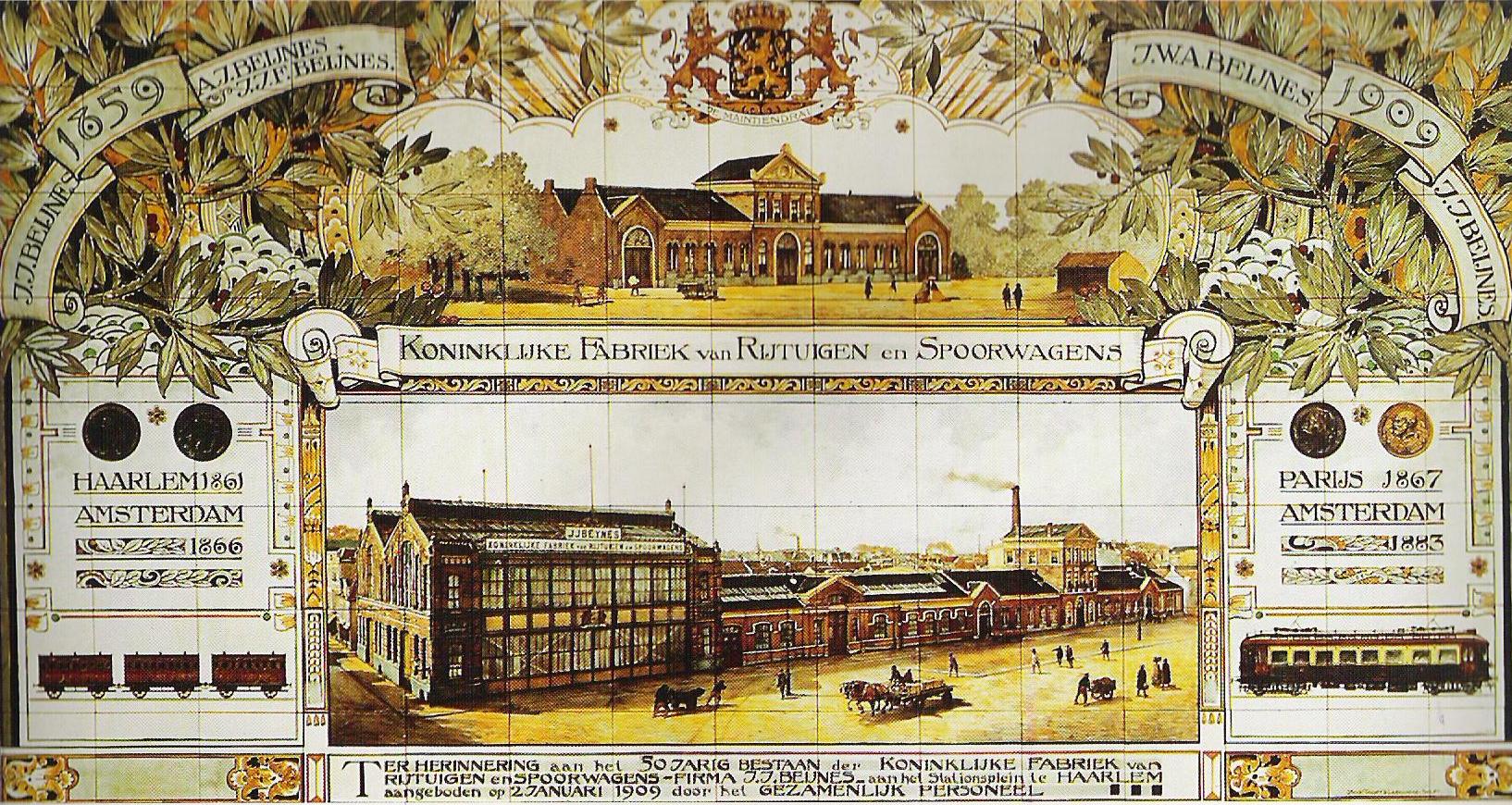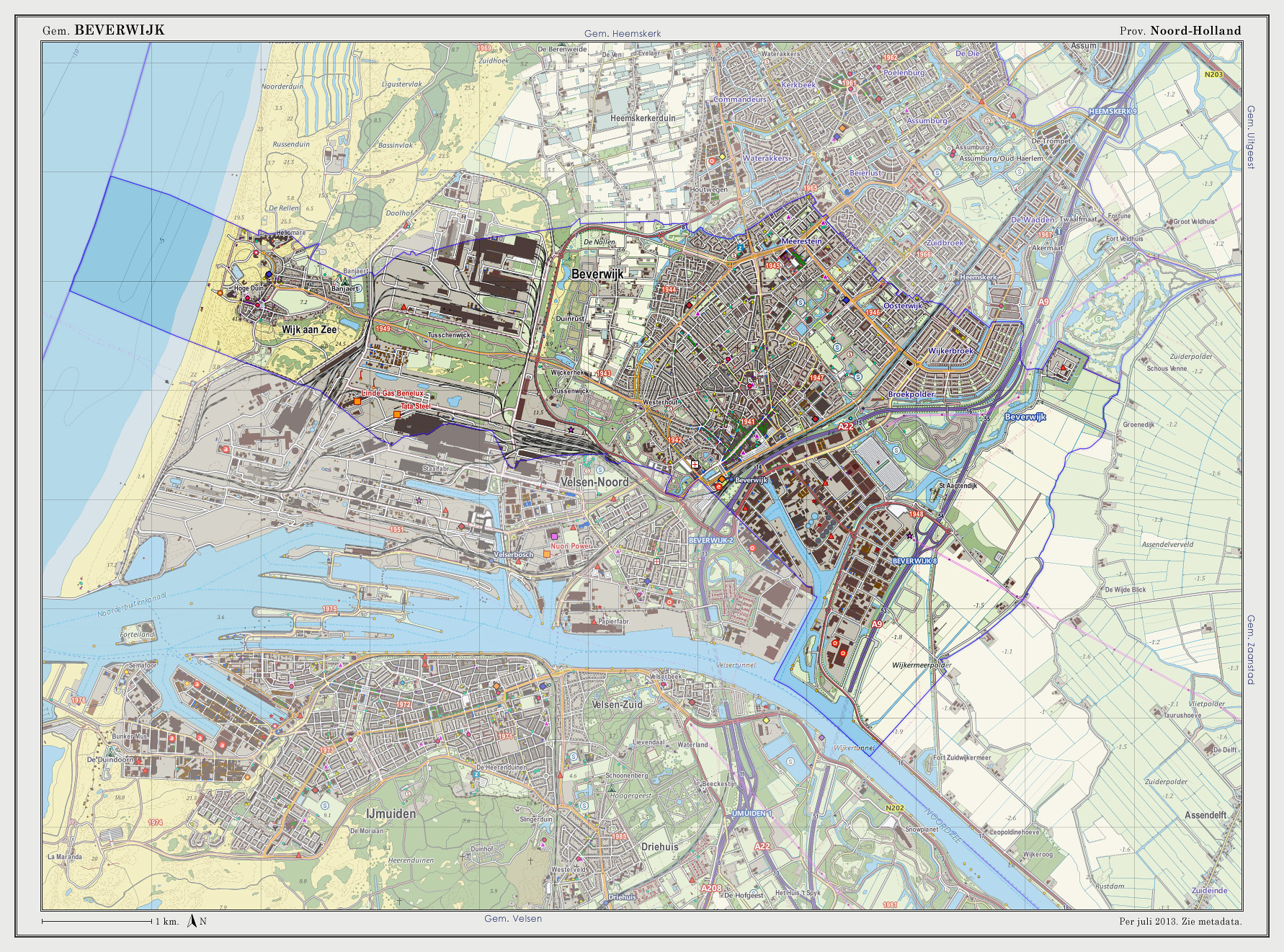|
Beijnes
Beijnes (1838 – 1963) is a defunct Haarlem manufacturer of carriages, buses, trains, and trams. It was closely associated with the Hollandsche IJzeren Spoorweg-Maatschappij (HIJSM) History J.J. Beijnes the elder opened a horse carriage shop (wagenmaker) behind the St. Bavochurch on the Riviervischmarkt in Haarlem in 1838."Beijnes : een eeuw van arbeid : 1838 - 1 november - 1838"; by Henri Asselberghs with color plates by Herman Heijenbroek and drawings by Herman Moerkerk; Impressum Haarlem : Spaarnestad, 1938 The painter and writer Jacobus van Looy described such a horse buggy servicing shop in detail in his autobiographical description of his early apprenticeships to a local typesetter and a local carriage shop owner in "Jaap", 1923. The increasing amount of ironwork needed for wagons of all types resulted in J.J. Beijnes merging his business with his brother A.J., a local smith, whose workshop was located at Grote Houtstraat 126 across from the Cornelissteeg in Haarlem. ... [...More Info...] [...Related Items...] OR: [Wikipedia] [Google] [Baidu] |
Haarlem
Haarlem (; predecessor of ''Harlem'' in English) is a city and municipality in the Netherlands. It is the capital of the province of North Holland. Haarlem is situated at the northern edge of the Randstad, one of the most populated metropolitan areas in Europe; it is also part of the Amsterdam metropolitan area, being located about 15 km to the west of the core city of Amsterdam. Haarlem had a population of in . Haarlem was granted city status or '' stadsrechten'' in 1245, although the first city walls were not built until 1270. The modern city encompasses the former municipality of Schoten as well as parts that previously belonged to Bloemendaal and Heemstede. Apart from the city, the municipality of Haarlem also includes the western part of the village of Spaarndam. Newer sections of Spaarndam lie within the neighbouring municipality of Haarlemmermeer. Geography Haarlem is located on the river Spaarne, giving it its nickname 'Spaarnestad' (Spaarne city). It is ... [...More Info...] [...Related Items...] OR: [Wikipedia] [Google] [Baidu] |
Haarlem Railway Station
Haarlem railway station is located in Haarlem in North Holland, Netherlands. The station opened at September 20, 1839, on the Amsterdam–Rotterdam railway, the first railway line in the Netherlands. The station building itself is a '' rijksmonument''. History The original, wooden station was built on the Oude Weg, just outside the Amsterdamse Poort in 1839 to accommodate the passengers of the first railway in the Netherlands between Haarlem and Amsterdam. This had a broad gauge rail width of the Dutch broad gauge . The station was built outside the city, on the current location of the ''Centrale Werkplaats'' (maintenance depot) of the Hollandsche IJzeren Spoorweg-Maatschappij. At great expense, the track gauge was reduced in 1866 to in order to conform to George Stephenson's standard gauge. The train engine "De Snelheid" was the twin of the Amsterdam " Arend", which along with the carriages, were designed by Stephenson's apprentice, the English rail engineer Thomas Long ... [...More Info...] [...Related Items...] OR: [Wikipedia] [Google] [Baidu] |
Hollandsche IJzeren Spoorweg-Maatschappij
The Hollandsche IJzeren Spoorweg-Maatschappij () or HSM (''Hollands Iron Railway-Company'') was the first railway company in the Netherlands founded on 8 August 1837 as a private company, starting operation in 1839 with a line between Amsterdam and Haarlem. The company remained operational until 1938, when it merged with the Maatschappij tot Exploitatie van Staatsspoorwegen (SS) to form the Nederlandse Spoorwegen (NS). History The first line constructed was a line following the straight route of the Haarlemmertrekvaart canal, connecting Amsterdam with Haarlem, which opened on 20 September 1839. The line was quickly expanded to follow the Leidsevaart canal and reached Leiden in 1842, The Hague in 1843, and Rotterdam in 1847. Because this line is the oldest line in the Netherlands, it is now known as the Old Line. This line was originally built to Dutch broad gauge , but was converted to in 1866. The line started at the Amsterdam d'Eenhonderd Roe station on the west side of ... [...More Info...] [...Related Items...] OR: [Wikipedia] [Google] [Baidu] |
Charabanc
A charabanc or "char-à-banc" (often pronounced "sharra-bang" in colloquial British English) is a type of horse-drawn vehicle or early motor coach, usually open-topped, common in Britain during the early part of the 20th century. It has "benched seats arranged in rows, looking forward, commonly used for large parties, whether as public conveyances or for excursions". It was especially popular for sight-seeing or " works outings" to the country or the seaside, organised by businesses once a year. The name derives from the French ("carriage with wooden benches"), the vehicle having originated in France in the early 19th century. Although the vehicle has not been common on the roads since the 1920s, a few signs survive from the era; a notable example at Wookey Hole in Somerset warns that the road to the neighbouring village of Easton is unsuitable for charabancs. The word is in common usage especially in Northern England in a jocular way referring to works outings by coach. ... [...More Info...] [...Related Items...] OR: [Wikipedia] [Google] [Baidu] |
Defunct Manufacturing Companies Of The Netherlands
{{Disambiguation ...
Defunct (no longer in use or active) may refer to: * ''Defunct'' (video game), 2014 * Zombie process or defunct process, in Unix-like operating systems See also * * :Former entities * End-of-life product * Obsolescence Obsolescence is the state of being which occurs when an object, service, or practice is no longer maintained or required even though it may still be in good working order. It usually happens when something that is more efficient or less risky r ... [...More Info...] [...Related Items...] OR: [Wikipedia] [Google] [Baidu] |
Locomotive Manufacturers Of The Netherlands
A locomotive or engine is a rail transport vehicle that provides the motive power for a train. If a locomotive is capable of carrying a payload, it is usually rather referred to as a multiple unit, motor coach, railcar or power car; the use of these self-propelled vehicles is increasingly common for passenger trains, but rare for freight (see CargoSprinter). Traditionally, locomotives pulled trains from the front. However, push-pull operation has become common, where the train may have a locomotive (or locomotives) at the front, at the rear, or at each end. Most recently railroads have begun adopting DPU or distributed power. The front may have one or two locomotives followed by a mid-train locomotive that is controlled remotely from the lead unit. __TOC__ Etymology The word ''locomotive'' originates from the Latin 'from a place', ablative of 'place', and the Medieval Latin 'causing motion', and is a shortened form of the term ''locomotive engine'', which was first us ... [...More Info...] [...Related Items...] OR: [Wikipedia] [Google] [Baidu] |
Defunct Companies Of The Netherlands
{{Disambiguation ...
Defunct (no longer in use or active) may refer to: * ''Defunct'' (video game), 2014 * Zombie process or defunct process, in Unix-like operating systems See also * * :Former entities * End-of-life product * Obsolescence Obsolescence is the state of being which occurs when an object, service, or practice is no longer maintained or required even though it may still be in good working order. It usually happens when something that is more efficient or less risky r ... [...More Info...] [...Related Items...] OR: [Wikipedia] [Google] [Baidu] |
Beverwijk
Beverwijk () is a municipality and a city in the Netherlands, in the province of North Holland. The town is located about northwest of Amsterdam in the Randstad metropolitan area, north of the North Sea Canal very close to the North Sea coast. A railway tunnel and two motorway tunnels cross the canal between Beverwijk and the nearby city of Haarlem on the south side of the canal. Around 1640, a town called Beverwyck was founded in the Dutch colony of New Netherland. That town's modern name is Albany, New York. Population centres The municipality of Beverwijk consists of two cores, Beverwijk proper and Wijk aan Zee, to the west, right on the coast. History The name Beverwijk comes from ''Bedevaartswijk'', meaning "pilgrimage neighbourhood". The town formed at the Saint Agatha Church which was a pilgrimage location in the Middle Ages. Allegedly Agatha of Sicily appeared there in the 9th century to a virgin from Velsen who was fleeing from the Count of Kennemerland ... [...More Info...] [...Related Items...] OR: [Wikipedia] [Google] [Baidu] |
Hunger Winter
In politics, humanitarian aid, and the social sciences, hunger is defined as a condition in which a person does not have the physical or financial capability to eat sufficient food to meet basic nutritional needs for a sustained period. In the field of hunger relief, the term ''hunger'' is used in a sense that goes beyond the common desire for food that all humans experience, also known as an ''appetite''. The most extreme form of hunger, when malnutrition is widespread, and when people have started dying of starvation through lack of access to sufficient, nutritious food, leads to a declaration of famine. Throughout history, portions of the world's population have often suffered sustained periods of hunger. In many cases, hunger resulted from food supply disruptions caused by war, plagues, or adverse weather. In the decades following World War II, technological progress and enhanced political cooperation suggested it might be possible to substantially reduce the number of p ... [...More Info...] [...Related Items...] OR: [Wikipedia] [Google] [Baidu] |
Arend (locomotive)
''De Arend'' (; ''the eagle'') was one of the two first steam locomotives in the Netherlands. It was a 2-2-2 ''Patentee'' type built in England by R. B. Longridge and Company of Bedlington, Northumberland to run on the then standard Dutch track gauge of . On 20 September 1839, together with the ''Snelheid'' (Dutch for ''speed''), it hauled the first train of the Hollandsche IJzeren Spoorweg-Maatschappij between Amsterdam and Haarlem. It was withdrawn in 1857. In 1939 a replica of the ''De Arend'' was constructed for the 100th anniversary of the Dutch railways. It is displayed at the Nederlands Spoorwegmuseum (Dutch Railway Museum) in Utrecht. See also * Adler (locomotive) The ''Adler'' (German for "Eagle") was the first locomotive that was successfully used commercially for the rail transport of passengers and goods in Germany. The railway vehicle was designed and built in 1835 by the British railway pioneers ... References * * 2-2-2 locomotives Stea ... [...More Info...] [...Related Items...] OR: [Wikipedia] [Google] [Baidu] |
Jacobus Van Looy
Jacobus (Jac) van Looy (12 September 1855 – 24 February 1930) was a Dutch painter and writer. Biography Van Looy was the son of a carpenter, but his father lost his job when his eyesight began to fail. His mother died when he was five years old and when his father died soon afterwards, he ended up in the Haarlem municipal orphanage. He trained to become a house painter, but was able to follow drawing classes, from 1877 at the "Rijksacademie van Beeldende Kunsten" in Amsterdam. In 1884, he received the Prix de Rome, which allowed him to travel.Jac. van Looy in the RKD The years 1885-86 he spent traveling through , |







